By
Olivia
Rosane
and
Cristen
Hemingway
Jaynes
Quick
Key
Facts
-
Methane
is
the
second
most
important
greenhouse
gas
after
carbon
dioxide
and
is
responsible
for
around
one-third
of
current
global
heating. -
Atmospheric
methane
concentrations
have
increased
by
256
percent
since
pre-industrial
times. -
Methane
is
a
more
powerful
greenhouse
gas
than
carbon
dioxide
but
lasts
for
far
less
time
in
the
atmosphere;
over
a
20-year
period,
methane
traps
86
times
more
heat
per
unit
of
mass
than
CO2. -
Around
60
percent
of
methane
emissions
come
from
human-caused
sources
and
40
percent
come
from
natural
sources. -
Ninety
percent
of
human-caused
emissions
come
from
three
sources:
fossil
fuels,
agriculture
and
waste
storage. -
Currently
existing
strategies,
if
adopted,
would
be
enough
to
curb
methane
emissions
from
these
three
sources
by
45
percent
by
2030. -
It
is
possible
to
cut
methane
emissions
from
oil
and
gas
operations
by
70
percent
with
existing
technologies
and
methods
and
by
40
percent
at
no
cost. -
Studies
have
shown
that
adding
seaweed
supplements
to
the
diets
of
cattle
can
decrease
their
methane
emissions
by
82
percent
for
feedlot
cattle,
more
than
50
percent
for
dairy
cows
and
42
percent
for
grazing
cattle
without
harming
the
animals. -
As
of
2023,
only
13
percent
of
all
methane
emissions
were
covered
by
any
sort
of
emissions-reduction
policy. -
If
everyone
in
the
European
Union
limited
their
meat
and
dairy
consumption
by
34
percent,
they
would
prevent
six
million
metric
tons
of
methane
emissions
per
year.
What
Is
Methane?
What
has
no
color
or
smell
and
is
found
in
wetlands,
cow
burps
and
your
basement
furnace?
The
answer
is
methane
—
a
powerful
greenhouse
gas
that
is
the
second
most
important
contributor
to
the
climate
crisis
after
carbon
dioxide
(CO2).
It
is
the
primary
component
of
natural
gas,
which
currently
generates
around
25
percent
of
the
world’s
electricity.
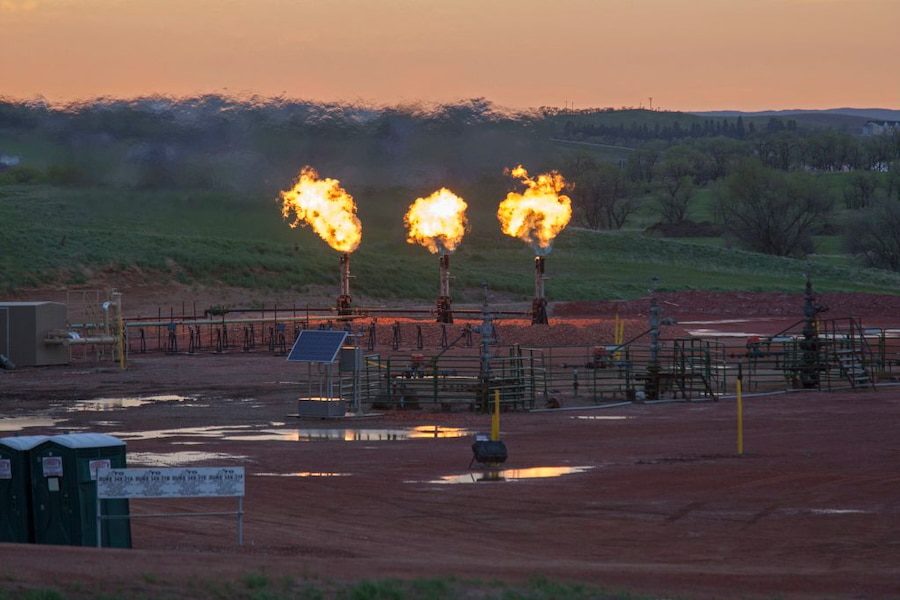
gas
is
flared
off
as
oil
is
pumped
in
the
Bakken
shale
formation
in
Watford
City,
North
Dakota
on
May
28,
2014.
Jim
West
/
UCG
/
Universal
Images
Group
via
Getty
Images
Methane
is
a
hydrocarbon
composed
of
four
hydrogen
atoms
bonded
to
a
carbon
atom.
It
is
abundant
in
nature
and
can
be
formed
by
both
geological
and
biological
processes.
Geologically,
methane
is
typically
created
when
heat
and
pressure
are
applied
to
decomposing
plant
and
animal
matter
over
millions
of
years.
This
is
the
source
of
most
natural
gas.
Methane
can
also
form
deep
underground
without
any
organic
matter
through
other
processes.
Biologically,
methane
is
generated
through
something
called
methanogenesis,
when
certain
underwater
microorganisms
called
archaea
produce
methane
as
part
of
their
oxygen-free
respiration
process.
This
is
how
methane
is
generated
above
ground,
such
as
in
wetlands
or
in
the
digestive
tracts
of
termites
and
cows.
How
Is
Methane
Measured?
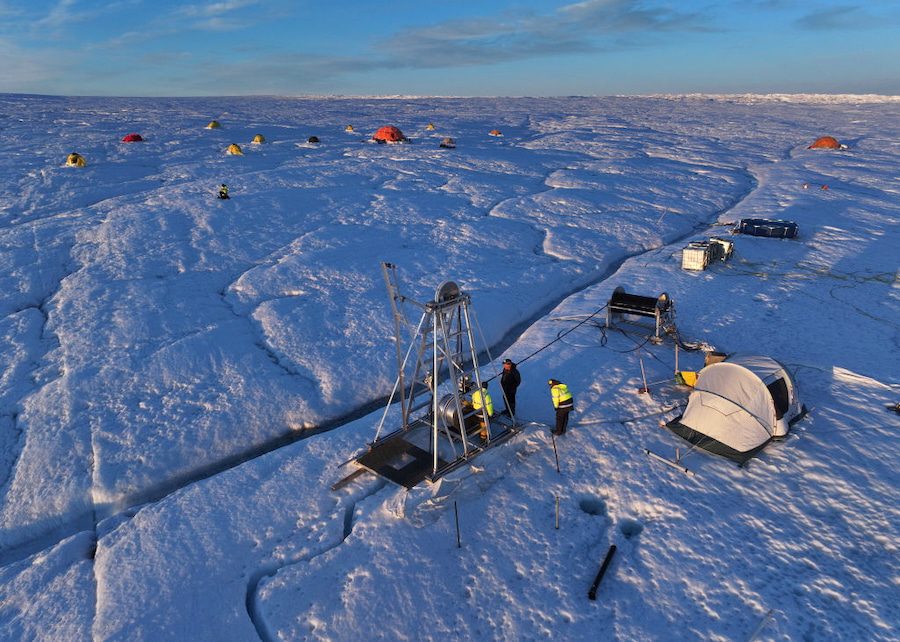
and
engineers
measure
methane
on
the
Isunnguata
Sermia
glacier
of
the
Greenland
Ice
Sheet
in
western
Greenland
on
July
9,
2024.
Sean
Gallup
/
Getty
Images
Methane
is
measured
via
two
main
methods:
bottom
up
and
top
down.
These
methods
work
almost
exactly
as
they
sound.
Bottom-up
approaches
begin
on
the
ground
with
a
localized
source
of
methane
and
expand
outward.
These
assessments
can
either
be
based
on
direct
measurements
of
a
given
facility’s
methane
emissions
or
by
estimations
based
on
general
knowledge
about
the
emitting
animal
or
equipment.
For
example,
to
estimate
the
methane
produced
by
a
region
or
country’s
beef
or
dairy
sector,
a
bottom-up
approach
could
multiply
the
methane
emitted
per
cow
by
the
number
of
cows
being
raised.
A
similar
approach
could
be
used
to
calculate
the
methane
released
by
a
county’s
natural
gas
facilities
or
a
region’s
oil
drilling
operations.
Top
down
approaches
often
literally
start
in
the
sky
with
measurements
of
atmospheric
methane,
usually
via
airplane,
high-altitude
platforms
or,
increasingly,
satellites.
This
data
can
then
be
combined
with
knowledge
of
where
there
are
methane
sources
and
sinks
and
used
to
create
models
of
methane
emissions.
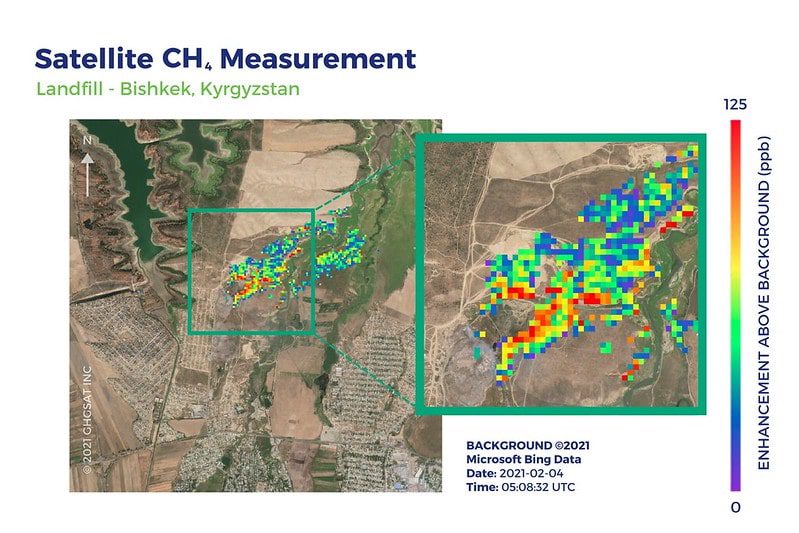
Satellite
image
of
methane
emissions
from
a
landfill
in
Kyrgyzstan
on
Feb.
4,
2021.
GHGSat
As
satellite
technology
improves,
it
is
detecting
super-emitting
incidents
that
are
not
reflected
in
bottom-up
approaches.
For
example,
if
a
gas
company
assesses
its
methane
emissions
by
multiplying
the
standard
leak
rate
of
a
piece
of
equipment
by
the
number
of
pieces
of
that
equipment
it
uses,
it
will
miss
the
five
percent
of
extraordinary
leaks
that
are
responsible
for
more
than
half
of
all
gas-industry
leak
emissions.
Overall,
direct
measurements
—
whether
from
the
ground
or
the
air
—
are
important
for
accurately
measuring
fossil
fuel
methane
emissions
in
particular.
One
study
found
that
direct
measurements
of
U.S.
oil
and
gas
methane
emissions
were
60%
higher
than
U.S.
Environmental
Protection
Agency
estimates.
In
general,
improving
methane
measurements
is
essential
for
understanding
and
therefore
controlling
its
emissions.
How
Does
Methane
Contribute
to
the
Climate
Crisis?
Methane
is
a
greenhouse
gas,
which
means
that,
when
it
enters
the
atmosphere,
it
absorbs
heat
energy
emitted
from
the
planet
and
redirects
it
back
toward
the
ground.
There
are
natural
methane
sinks
—
namely
soil
and
the
troposphere,
where
methane
is
broken
down
into
carbon
dioxide
and
water
vapor.
These
sinks
are
able
to
counteract
naturally
occurring
methane
emissions
so
that
the
gas
does
not
build
up
in
the
atmosphere.
However,
human
activities
since
the
start
of
the
industrial
revolution
—
particularly
the
burning
of
fossil
fuels,
more
intensive
forms
of
agriculture
and
waste
storage
—
have
raised
the
concentration
of
methane
in
the
atmosphere
faster
than
natural
sinks
can
absorb
it.
As
of
2023,
the
most
recent
year
for
which
data
is
available,
atmospheric
methane
concentration
had
soared
by
265
percent
to
1,934
ppb
compared
with
pre-industrial
levels.
Around
60
percent
of
that
methane
was
emitted
due
to
human
activities.
That
methane
has
contributed
to
around
one-third
of
current
global
heating,
second
to
CO2
at
around
two-thirds.
If
nothing
is
done
to
reduce
methane
emissions,
they
are
projected
to
rise
by
13
percent
between
2020
and
2030.
Controlling
methane
emissions
is
essential
for
addressing
the
climate
crisis
because
methane
is
both
more
potent
than
CO2
and
also
lasts
for
a
shorter
period
of
time
in
the
atmosphere,
approximately
12
years
compared
with
hundreds.
Over
a
20-year
period,
methane
traps
86
times
more
heat
per
unit
of
mass
than
CO2,
which
falls
to
28
times
more
over
100
years.
The
combination
of
methane’s
potency
and
relatively
short
atmospheric
lifespan
means
that
reducing
methane
emissions
delivers
a
powerful
bang
for
one’s
buck
in
terms
of
rapidly
curbing
greenhouse
gasses
and
stabilizing
global
temperatures.
In
fact,
the
Global
Methane
Assessment
concluded
that
curbing
methane
“is
very
likely
the
strategy
with
the
greatest
potential
to
decrease
warming
over
the
next
20
years.”
The
Intergovernmental
Panel
on
Climate
Change
(IPCC)
has
calculated
that
methane
emissions
must
be
reduced
by
around
34
percent
by
2030
when
compared
with
2019
levels
in
order
to
limit
global
heating
to
1.5
degrees
Celsius
above
pre-industrial
levels.
What
Are
the
Main
Sources
of
Methane?
Methane
comes
from
both
human
and
natural
sources,
with
human-caused
emissions
responsible
for
around
60
percent
of
atmospheric
methane
and
natural
sources
around
40
percent.
More
than
90
percent
of
current
human-caused
methane
emissions
come
from
three
sources:
agriculture,
fossil
fuels
and
waste
storage.
The
burning
of
biomass
and
the
use
of
biofuels
also
emit
methane
but
are
less
important,
as
they
are
responsible
for
around
five
percent
of
emissions.
Wetlands
and
freshwater
are
the
leading
source
of
natural
methane
emissions,
followed
by
geological
sources
such
as
gas-oil
seeps
and
volcanoes,
termites,
oceans,
wild
animals
and
permafrost.
In
addition,
there
are
natural
sources
of
methane
that
could
play
a
larger
role
in
the
future
as
the
climate
crisis
triggers
various
feedback
loops.
Agriculture
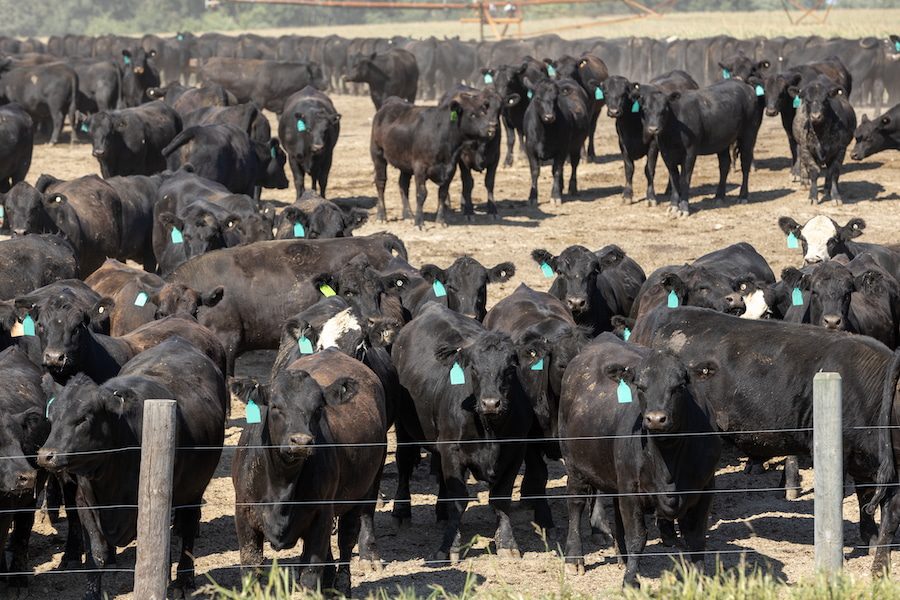
Angus
breed
cattle
in
a
feedlot.
Clinton
Austin
/
iStock
/
Getty
Images
Plus
Around
40
percent
of
human-caused
methane
emissions
come
from
agriculture.
The
vast
majority
of
these
emissions
are
from
livestock,
which
alone
generate
around
32
percent
of
human-caused
methane
emissions.
This
is
primarily
from
enteric
fermentation,
which
is
how
ruminant
animals
like
cows,
sheep
and
goats
digest
their
food.
Microbes
in
these
animals’
digestive
systems
break
down
nutrients
and
produce
methane
as
a
byproduct.
When
it
comes
to
methane
emissions,
cows
raised
for
meat
or
milk
are
the
primary
contributors.
Another
way
that
livestock
agriculture
can
generate
methane
is
through
the
storage
of
manure,
particularly
that
of
pigs
and
cows.
As
meat
consumption
increases,
these
emissions
are
projected
to
rise
by
six
million
metric
per
year
by
2030.
A
second
important
agricultural
contribution
to
human-caused
methane
emissions
is
the
cultivation
of
rice
at
eight
percent.
Rice
is
grown
in
flooded
patties,
an
environment
that
encourages
the
growth
of
methane-producing
microbes.
Finally,
around
one
percent
of
human-caused
methane
emissions
are
caused
by
the
burning
of
agricultural
waste.
Fossil
Fuels
The
extraction
and
burning
of
fossil
fuels
contribute
around
35
percent
of
human-caused
methane
emissions.
Primarily,
this
occurs
through
the
extraction,
transport
and
use
of
oil
and
gas,
at
23
percent
of
human-caused
emissions.
Methane
is
typically
released
during
venting,
when
unwanted
gas
is
released
into
the
atmosphere
during
the
extraction
process,
as
well
as
through
accidental
leaks
from
extraction
to
transport
to
use.
Emissions
from
oil
and
gas
are
expected
to
increase
by
10
million
metric
tons
per
year
by
2030,
in
particular
because
of
the
use
of
natural
gas.
Around
12
percent
of
human-caused
methane
emissions
are
released
during
the
process
of
mining
coal,
or
from
leaks
from
abandoned
coal
mines.
Methane
naturally
occurs
along
coal
seams,
and
can
be
released
in
several
ways
during
the
mining
process:
through
seepage
when
the
coal
is
exposed
to
the
surface,
through
drainage
systems,
through
ventilation
systems
to
reduce
methane
buildup
in
a
mine
for
safety
reasons
and
from
the
coal
itself
as
it
is
removed
from
the
mine.
Underground
mines
tend
to
emit
more
methane
than
surface
mines,
at
70
percent
of
mine
emissions.
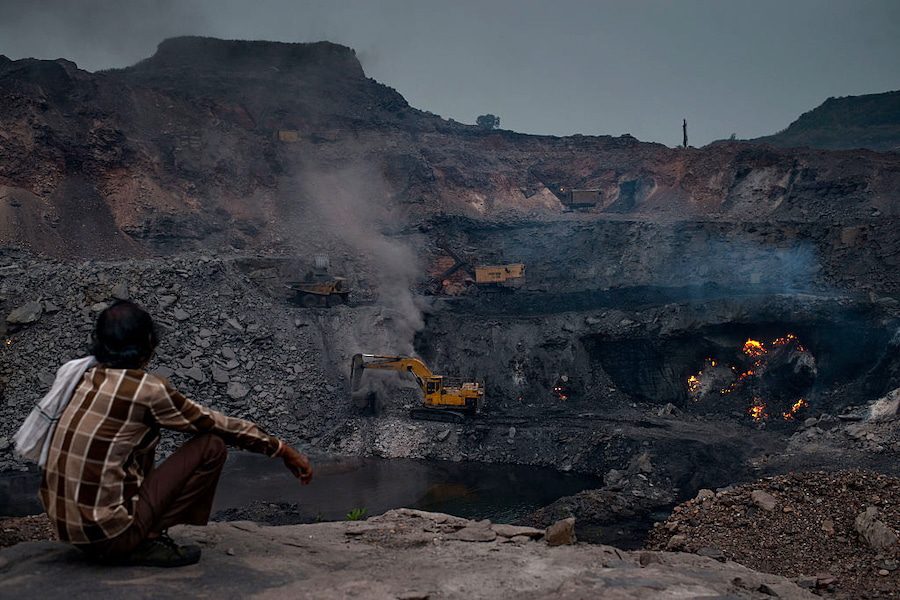
coal
mine
in
Jharia,
India
oozes
fire,
methane
and
other
toxic
gases
on
Oct.
25,
2014.
Jonas
Gratzer
/
LightRocket
via
Getty
Images
Certain
fossil
fuel
projects
emit
massive
amounts
of
methane
at
once,
usually
due
to
leaks
or
venting.
These
are
called
“super-emitters”
and
are
detectable
through
satellite
imaging.
In
2022,
researchers
detected
more
than
1,005
human-caused
super-emitter
incidents
—
559
at
oil
and
gas
fields
and
105
at
coal
mines.
The
worst,
in
Turkmenistan,
spewed
427
metric
tons
of
methane
per
hour,
the
equivalent
of
the
hourly
emissions
of
France.
As
methane
emissions
increased
in
the
2010s,
experts
think
that
fossil
fuel
activities
contributed
as
much
as
agriculture
and
waste
storage
combined.
Landfills
and
Waste
Around
20
percent
of
human-caused
methane
emissions
come
from
landfills
and
waste
management
systems.
This
is
because
microbes
present
in
wastewater
treatment
facilities
and
landfills
release
methane
as
they
decompose
the
waste.
This
can
generate
lots
of
methane
at
once:
Of
the
1,005
super-emitter
events
identified
by
researchers
in
2022,
340
were
from
waste
sites.
Because
of
population
growth
and
projected
development
in
poorer
countries,
emissions
from
waste
are
expected
to
grow
faster
than
from
any
other
human-caused
methane
source
at
13
million
metric
tons
per
year
by
2030.
The
amount
of
human-disposed
solid
waste
overall
is
expected
to
rise
by
73
percent
by
2050.
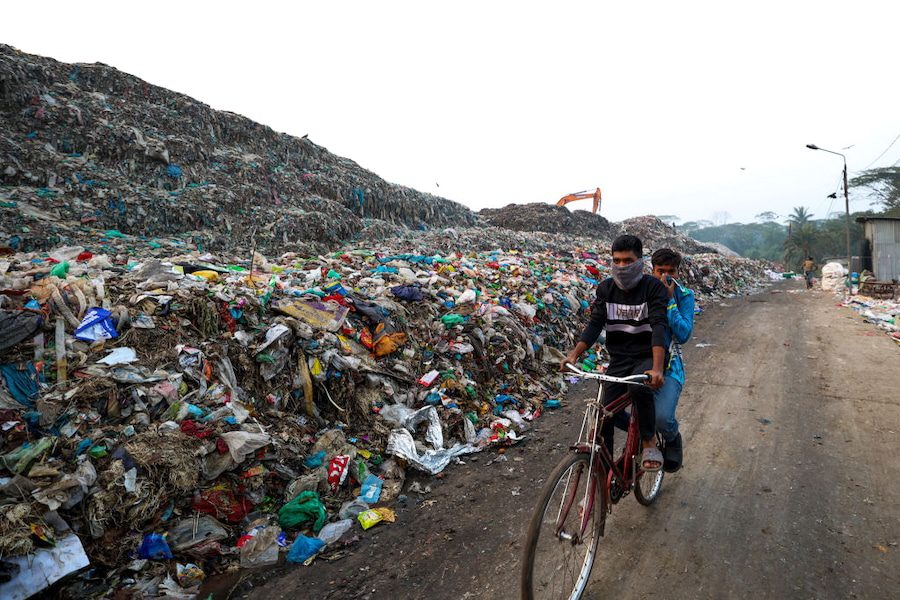
pass
a
landfill
that
is
a
huge
emitter
of
methane
in
Barisal,
Bangladesh
on
Jan.
21,
2025.
Niamul
Rifat
/
Anadolu
via
Getty
Images
Wetlands
Wetlands
are
the
predominant
source
of
natural
methane
emissions,
accounting
for
around
one-third
of
total
methane
emissions.
This
is
because
wetlands
—
which
cover
around
six
percent
of
the
Earth’s
land
area
—
are
defined
by
having
their
soils
saturated
with
water
for
all
or
part
of
the
year.
This
creates
a
wet,
oxygen-poor
environment
that
creates
ideal
conditions
for
the
archaea
responsible
for
methanogenesis.
While
wetlands
would
produce
methane
no
matter
what
humans
do,
the
climate
crisis
has
led
to
an
increase
in
wetland
methane
emissions
in
recent
years
due
to
temperature
increases
and
changing
rainfall
patterns.
This
is
known
as
the
“wetland
methane
feedback.”
Between
2000
and
2020,
wetland
methane
emissions
increased
by
1.2
to
1.4
million
metric
tons
per
year,
which
is
a
higher
rate
than
anticipated
by
the
most
pessimistic
emissions
scenarios.
Scientists
noted
that
these
emissions
saw
“exceptional
growth”
in
2020
to
2021
in
particular.
The
researchers
traced
this
increase
to
two
sources:
tropical
wetlands
and
permafrost
wetlands.
Tropical
wetlands
are
expanding
their
area
due
to
climate-fueled
changes
in
rainfall
patterns
and
were
the
major
driver
of
increased
wetland
methane
emissions
in
the
early
21st
century.
Permafrost
wetlands
are
located
in
the
Arctic
and,
as
the
name
suggests,
are
partially
frozen
in
addition
to
being
waterlogged.
When
warmer
temperatures
cause
permafrost
to
melt,
they
also
unfreeze
the
microbes
that
release
methane.
Arctic
wetlands
have
also
expanded
by
25
percent
during
the
summer
due
to
a
rise
in
precipitation.
Oceans
The
ocean
is
responsible
for
one
to
13
percent
of
natural
methane
emissions
through
various
mechanisms
including
geological
marine
seepage;
emissions
from
ocean
sediments
or
melting
underwater
permafrost;
emissions
near
coastal
areas
where
groundwater
enters
the
sea;
and
the
destabilization
of
methane
hydrates,
which
are
ice-like
formations
of
methane
and
water
on
the
seafloor.
The
largest
concentration
of
methane
on
Earth
is
stored
in
these
hydrates,
and
there
are
concerns
that,
as
the
climate
crisis
causes
oceans
to
warm,
these
deposits
might
melt
and
release
massive
amounts
of
methane
into
the
atmosphere.
However,
there
is
no
evidence
that
any
methane
from
these
hydrates
is
currently
reaching
the
atmosphere.
Positive
Climate
Feedback
Loops
A
positive
feedback
loop
occurs
when
a
change
to
a
given
system
triggers
other
changes
that
amplify
that
initial
change.
In
the
case
of
the
climate
emergency,
a
positive
feedback
loop
occurs
when
the
impacts
of
global
heating
interact
with
Earth’s
systems
in
ways
that
trigger
more
warming.
When
these
changes
pass
a
certain
threshold,
it
can
alter
the
system
in
dramatic
and
irreversible
ways.
This
is
called
a
climate
tipping
point.
Methane
is
involved
in
several
positive
feedback
loops,
of
which
the
wetland
methane
feedback
is
just
one
example.
Another
related
example
is
the
thawing
of
the
Arctic
permafrost,
frozen
soils
on
land
as
well
as
beneath
the
Arctic
Ocean.
The
material
that
is
frozen
beneath
the
permafrost
contains
plant
and
animal
matter,
as
well
as
microbes
that
would
produce
methane
if
they
thawed
out.
The
permafrost
beneath
the
ocean
contains
methane
hydrates.
This
means
that
the
Arctic
currently
contains
2.5
times
more
carbon
underground
than
exists
in
the
atmosphere.
Thawing
the
permafrost
would
release
all
or
some
of
that
carbon,
triggering
a
major
tipping
point.
This
process
has
already
begun,
with
Arctic
and
Boreal
methane
emissions
increasing
by
9
percent
since
2002.
Scientists
don’t
know
exactly
how
much
methane
the
melting
permafrost
might
ultimately
release,
but
the
region
is
currently
on
pace
to
release
the
greenhouse
gas
emissions
of
a
major
industrialized
nation
if
nothing
is
done
to
reduce
warming.
Another
positive
climate
feedback
loop
involving
methane
is
the
increase
in
the
frequency,
severity
and
size
of
wildfires.
A
warmer
climate
makes
the
hot,
dry
conditions
that
fuel
wildfires
more
likely,
and
these
fires
in
turn
release
carbon
dioxide
and
methane
into
the
atmosphere
as
they
burn,
fueling
more
warming.
Larger
fires
also
tend
to
release
more
methane.
One
study
found
that
California’s
record-breaking
2020
wildfire
season
contributed
almost
14
percent
of
the
state’s
total
methane
emissions
for
the
year.
Methane
and
the
‘Bridge
Fuel’
Myth
Another
reason
methane
emissions
might
spike
in
the
future
is
the
expansion
of
gas
production,
including
an
increase
in
exports
of
liquefied
natural
gas
(LNG).
The
development
and
spread
of
fracking
in
the
U.S.,
Canada
and
Australia
in
particular
has
made
gas
much
more
abundant
and
set
off
a
construction
boom
in
infrastructure
to
export
and
import
the
fuel.
The
U.S.
has
massively
increased
its
LNG
exports
since
it
lifted
a
ban
on
them
in
2016,
becoming
the
No.
1
natural
gas
exporter
in
the
world
by
2022.
These
exports
doubled
between
2019
and
2021
and
will
double
again
in
four
years
if
they
continue.
Advocates
of
natural
gas
have
argued
that
it
is
a
“bridge
fuel”
from
coal
to
more
renewable
sources
of
energy.
This
is
because
when
burned
for
energy,
coal
emits
twice
as
much
carbon
dioxide
per
kilowatt-hour
as
natural
gas.
In
the
U.S.,
direct
power
plant
emissions
decreased
by
almost
40
percent
in
the
first
decades
of
the
21st
century,
as
gas
overtook
coal
as
the
country’s
leading
electricity
fuel
source.
Proponents
of
exporting
U.S.
LNG
argue
that
it
would
similarly
displace
coal
use
in
Europe
and
Asia.
However,
this
ignores
the
methane
that
leaks
during
the
process
of
extracting
and
transporting
LNG.
If
only
0.2
percent
of
methane
leaks,
it
makes
LNG
as
climate-warming
as
coal,
and
new
data,
including
satellite
imagery,
suggests
that
the
amount
of
methane
leaks
have
been
vastly
underestimated.
A
2023
study
calculated
that,
when
methane
leaks
are
taken
into
account,
LNG
has
a
33%
greater
global
warming
potential
over
20
years
than
coal.
Further,
the
Department
of
Energy
recently
concluded
that
LNG
exports
are
more
likely
to
replace
renewable
energy
sources
than
coal.
This
new
understanding
comes
as
more
gas
fields
and
LNG
export
and
import
terminals
are
being
planned.
A
2022
analysis
found
that
there
are
55
“methane
bomb”
gas
fields
whose
future
methane
leaks
would
equal
30
years
of
U.S.
greenhouse
gas
emissions.
The
current
and
proposed
construction
of
LNG
export
terminals
in
the
U.S.,
meanwhile,
would
cancel
out
any
climate
progress
the
nation
has
made,
keeping
its
greenhouse
gas
emissions
frozen
at
2005
levels.
As
U.S.
climate
campaigner
Bill
McKibben
warned,
“If
the
LNG
build-out
continues
—
here
and
in
Canada
and
Australia
—
its
sheer
size
will
overwhelm
our
efforts
to
rein
in
global
warming.”
What
Are
Other
Benefits
to
Reducing
Methane
Emissions?
While
stopping
the
acceleration
of
the
climate
crisis
is
a
major
argument
for
reducing
methane
emissions,
these
emissions
don’t
just
heat
the
atmosphere.
They
also
contribute
to
ground-level
ozone,
which
forms
as
methane
reacts
to
the
atmosphere.
Ozone
at
ground
level
is
a
major
public
health
and
environmental
hazard
because
it
damages
human
lung
tissue,
triggering
respiratory
ailments,
and
harms
plants
including
agricultural
crops.
Currently,
methane-generated
ozone
causes
about
half
a
million
extra
deaths
per
year.
However,
every
million
metric
tons
of
methane
emissions
avoided
would
also
prevent
1,430
yearly
deaths
from
respiratory
and
heart
diseases;
4,000
asthma-related
emergencies
and
90
hospitalizations
per
year;
and
annual
losses
of
145,000
metric
tons
of
wheat,
soybeans,
maize
and
rice.
What
Can
Be
Done
to
Reduce
Methane
Emissions?
There
are
many
ways
to
reduce
methane
emissions
that
range
from
large-scale
transformations
of
energy
and
food
systems
to
smaller
technical
fixes.
Most
likely
a
combination
of
methods
will
be
necessary
to
control
methane
emissions
to
reduce
global
heating
and
ozone
pollution.
However,
currently
existing
methods,
if
adopted,
would
be
enough
to
curb
methane
emissions
from
the
three
main
human-caused
sources
—
fossil
fuels,
agriculture
and
waste
—
by
45%
by
2030,
in
line
with
the
IPCC’s
pathway
to
1.5
degrees.
From
Agriculture
There
are
two
main
ways
to
reduce
the
amount
of
methane
produced
by
the
food
system.
The
first
is
to
transform
the
food
system
altogether
by
reducing
meat
and
dairy
production.
This
can
be
done
in
part
by
reducing
food
waste,
as
30
to
40
percent
of
all
food
produced
is
lost
and
does
not
make
it
to
a
person’s
stomach.
According
to
one
calculation,
the
waste
of
ruminant
and
rice
products
is
responsible
for
around
50
million
metric
tons
of
methane
per
year,
and
reducing
it
could
cut
those
emissions
by
around
20
million
metric
tons.
Another
way
is
to
shift
toward
more
healthy,
sustainable
or
plant-based
diets,
including
by
reducing
overall
consumption
in
wealthier
countries.
According
to
the
IPCC,
doing
so
would
reduce
greenhouse
gas
emissions
overall
by
5.3
to
20.2
gigatons
of
carbon-dioxide
equivalent
by
2050.
Potential
emissions
reductions
from
dietary
shifts
run
from
0.7
to
eight
gigatons
of
carbon
dioxide
equivalent
per
year
by
2050,
under
scenarios
ranging
from
half
of
the
planet
adopting
a
“healthy”
diet
that
includes
less
than
six
grams
of
animal
protein
per
day
to
a
global
embrace
of
vegetarianism.
The
second
main
strategy
for
reducing
methane
emissions
from
agriculture
is
to
make
changes
to
existing
production
so
that
it
releases
less
methane.
One
way
to
do
this
is
to
increase
the
efficiency
of
animal
agriculture
so
that
more
meat
or
milk
is
produced
per
animal,
especially
in
poorer
countries.
This
can
be
done
without
sacrificing
animal
welfare
by
feeding
animals
better
diets,
including
highly
digestible
feed;
improving
animal
health
overall;
and
breeding.
Another
solution
is
to
add
enteric
methane
inhibitors
to
the
diets
of
ruminants,
which
prevent
methane
production
in
their
guts.
Promising
examples
are
the
chemical
3-NOP
and
seaweed.
Studies
have
shown
that
adding
seaweed
supplements
to
the
diets
of
cattle
can
decrease
their
methane
emissions
by
82
percent
for
feedlot
cattle,
more
than
50
percent
for
dairy
cows
and
42
percent
for
grazing
cattle
without
harming
the
animals
in
any
way.
Researchers
are
also
working
to
breed
ruminants
who
produce
less
methane
and
to
develop
a
vaccine
that
would
limit
gut
methane
production.
Another
major
source
of
agricultural
methane
that
can
be
targeted
for
reduction
is
manure
storage.
Solutions
include
reducing
the
amount
of
time
manure
is
stored;
covering
tanks
holding
semi-solid
waste;
separating
liquid
and
solid
manure;
and
adding
acid
to
manure
storage
facilities,
which
inhibits
the
growth
of
methane-producing
microbes.
Another
solution
that
has
been
adopted
in
recent
years
is
the
use
of
manure
digesters,
which
turn
manure
into
biogas,
reducing
manure’s
methane
emissions
and
providing
a
non-fossil
form
of
energy.
However,
there
are
emerging
concerns
that
methane
leaks
from
these
machines
may
undermine
their
impact.
Finally,
emissions
from
rice
can
be
curbed
by
various
methods.
One
strategy
is
to
grow
either
higher
yield
or
lower-methane
varieties
of
rice,
which
reduce
the
amount
of
methane
emitted
per
kilogram.
Planting
lower-methane
rice
could
cut
emissions
by
22
to
51
percent.
Another
option
is
to
change
how
rice
is
grown
by
using
Alternative
Wetting
and
Drying.
Instead
of
keeping
rice
paddies
flooded,
this
method
involves
letting
them
dry
out
completely
before
flooding
again
and
can
decrease
emissions
by
40
to
45
percent.
Finally,
adding
phosphogypsum
and
sulphate
to
rice
fields
can
decrease
microbial
methane
production.
From
Fossil
Fuels
The
No.
1
way
to
reduce
methane
emissions
from
fossil
fuels
is
to
phase
out
their
use
entirely
as
soon
as
possible
while
rapidly
transitioning
to
renewable
forms
of
energy
that
do
not
emit
methane
and
in
particular
to
halt
the
buildout
of
LNG
infrastructure.
However,
there
are
also
ways
to
reduce
the
methane
emissions
from
fossil
fuel
infrastructure
still
in
use,
and
in
fact
reducing
methane
emissions
from
ongoing
oil
and
gas
operations
is
considered
the
strategy
with
the
most
short-term
potential
for
significant
methane
cuts.
According
to
the
International
Energy
Agency
(IEA),
it
is
possible
to
slash
the
oil
and
gas
sector’s
methane
emissions
by
70%
with
existing
technologies
and
methods
and
by
40%
at
no
cost.
These
methods
include
leak
detection
and
repair,
installing
devices
to
detect
methane
and
phasing
out
equipment
that
releases
methane
when
used.
For
coal,
it
is
more
difficult
to
reduce
emissions
while
still
mining
and
burning
coal,
but
there
are
strategies
such
as
requiring
new
mines
to
use
degasification
wells
and
drainage
boreholes
to
capture
methane
and
capturing
and
reusing
methane
in
existing
mines.
It
is
also
possible
to
avoid
methane
emissions
from
equipment
no
longer
in
use
by
capping
abandoned
gas
wells
and
flooding
retired
mines.
From
Landfills
and
Waste
Ideally,
the
best
way
to
reduce
methane
waste
from
landfills
would
be
to
move
toward
a
zero-waste
circular
economy
that
reuses
all
material
throughputs.
Specific
strategies
toward
this
goal
include
reducing
food
waste,
keeping
organic
waste
out
of
landfills
and
diverting
it
toward
composting
systems,
capturing
methane
emissions
from
landfills
and
covering
landfills
with
soil
containing
organisms
that
can
break
down
methane.
Reducing
methane
emissions
from
wastewater
can
mostly
be
achieved
by
upgrading
treatment
facilities.
This
includes
replacing
latrines
with
actual
wastewater
treatment
plants
and
making
sure
that
facilities
that
provide
primary
treatment
—
removing
solid
pollution
—
also
provide
secondary
treatment
—
removing
organic
matter
and
nutrients
with
the
help
of
bacteria
and
microorganisms
—
and
tertiary
chemical
treatment.
Wastewater
treatment
plants
can
also
be
built
to
capture
and
reuse
biogas.
Direct
Removal
While
it
is
important
to
rapidly
move
to
reduce
human-caused
methane
emissions,
some
scientists
are
investigating
methods
of
directly
removing
methane
from
the
atmosphere
to
augment
these
efforts.
This
can
be
achieved
in
two
main
ways:
by
bolstering
the
abilities
of
natural
ecosystems
to
remove
and
store
methane
and
through
direct
geoengineering.
On
the
ecosystem
side,
scientists
have
discovered
that
tree
bark
has
remarkable
methane-absorbing
abilities,
as
it
contains
organisms
called
methanotrophs
that
essentially
eat
methane.
Preserving
forests,
reforesting
or
intentionally
planting
tree
species
that
have
greater
methane-storing
ability
could
all
be
ways
to
take
advantage
of
this
nature-based
solution.
A
potential
geoengineering
method
would
be
to
release
iron
salt
into
the
atmosphere.
This
would
mimic
what
happens
when
dust
from
Sahara
sand
storms
collides
with
the
sea
spray
of
the
Atlantic
—
instigating
a
chemical
process
that
breaks
down
methane.
However,
more
research
is
required
to
determine
if
and
how
this
could
be
done
both
safely
and
effectively.
Ultimately,
it
is
safest
to
rely
on
the
methods
that
we
know
work
to
stop
methane
from
reaching
the
atmosphere
in
the
first
place.
What
Progress
Has
Been
Made
to
Reduce
Methane
Emissions
So
Far?
At
the
COP26
United
Nations
climate
change
conference
in
2021
in
Glasgow,
Scotland,
the
UK
and
United
States
launched
the
Global
Methane
Pledge.
As
of
January
2025,
a
total
of
159
nations
had
joined
the
pledge.
Pledge
members
agreed
to
work
toward
cutting
global
methane
emissions
by
30%
of
2020
levels
by
2030.
Doing
so
would
be
consistent
with
limiting
global
warming
to
1.5
degrees
Celsius
above
pre-industrial
levels
and
could
prevent 0.2
degrees
Celsius
of
warming
by
2050.
While
the
pledge’s
website
claims
that
it
has
“generated
unprecedented
for
methane
mitigation,”
this
is
yet
to
manifest
in
real-world
reductions.
Methane
emissions
broke
a
new
record
in
2023,
the
most
recent
year
for
which
data
is
available.
Even
though
the
oil
and
gas
sector
offers
the
most
possibility
for
rapid
methane
cuts,
and
roughly
80%
of
that
sector
falls
under
a
methane-reduction
pledge,
its
total
emissions
have
continued
to
rise
since
2020
and
remained
past
120
million
metric
tons
per
year
in
2024.
All
methane
pledges
made
by
governments
and
companies
as
of
2023
would
in
theory
be
enough
to
reduce
fossil
fuel
methane
emissions
by
50%
by
2030,
but
to
do
this
the
industry
must
close
its
implementation
gap.
Further,
there
are
major
gaps
in
these
commitments.
As
of
2023,
only
13
percent
of
all
methane
emissions
were
covered
by
any
sort
of
emissions-reduction
policy.
What
Can
Individuals
Do
to
Reduce
Methane
Emissions?
The
two
simplest,
most
effective
things
that
people
can
do
to
reduce
their
individual
methane
emissions
are
to
switch
to
lower-methane
diets
and
to
reduce
their
daily
food
waste
through
measures
such
as
meal
planning,
buying
“ugly”
foods
and
composting.
If
you
feel
intimidated
at
the
thought
of
going
entirely
vegetarian
or
vegan,
even
just
reducing
your
meat
and
dairy
consumption
can
make
a
difference.
One
study
found
that
if
everyone
in
the
European
Union
limited
their
meat
and
dairy
consumption
by
34%,
they
would
prevent
six
million
metric
tons
of
methane
emissions
per
year.
If
you
are
a
homeowner
who
either
cooks
on
a
gas
stove
or
receives
heat
via
a
gas
furnace,
you
can
replace
your
gas
range
with
an
electric
or
induction
option
and
swap
your
furnace
for
an
electric
heat
pump.
Renters
may
not
be
able
to
swap
out
appliances,
but
they
can
still
reduce
their
gas
use
by
finding
creative
ways
to
save
energy
—
such
as
air-drying
clothes
—
or
supplementing
gas
heating
and
cooking
appliances
with
electric
devices
like
space
heaters,
rice
cookers,
microwaves
or
induction
burners.
Ultimately,
methane
emissions
—
like
all
climate
pollution
—
are
the
products
of
complex
energy,
food
and
waste
systems
that
are
kept
in
place
partly
because
they
benefit
powerful
people
who
are
currently
profiting
from
them.
Reducing
your
personal
methane
emissions
will
not
remake
those
systems
on
its
own,
but
you
can
also
join
together
with
like-minded
people
to
campaign
for
change.
This
could
range
from
lobbying
your
city
government
to
create
a
municipal
composting
system
to
joining
or
supporting
groups
like
350.org,
Third
Act,
Oil
Change
International,
Louisiana
Bucket
Brigade
and
South
Texas
Environmental
Justice
Network
that
are
working
to
stop
the
LNG
buildout
globally,
nationally
and
in
their
communities.
Takeaway
Methane
emissions
present
both
a
threat
and
an
opportunity.
Because
methane
is
so
much
more
potent
than
carbon
dioxide,
it
can
further
turbocharge
the
global
heating
that
is
already
raising
the
thermostat
and
fueling
more
extreme
storms
and
other
weather
events.
However,
its
shorter
atmospheric
lifespan
means
that
acting
urgently
to
cut
its
emissions
would
enable
us
to
make
important
and
timely
headway
on
combating
the
climate
crisis
overall.
That
is
why
it’s
important
to
spread
the
word
about
methane
—
how
it’s
released
and
how
to
reduce
it
—
and
to
put
pressure
on
political
and
business
leaders
to
act
on
that
knowledge.



